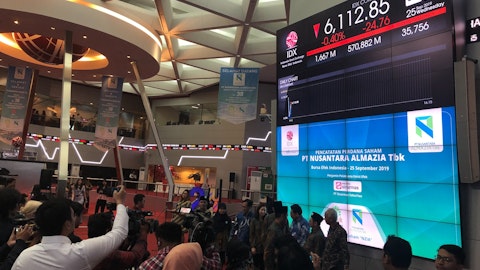Accenture plc (NYSE:ACN) Q2 2024 Earnings Call Transcript March 21, 2024
Accenture plc beats earnings expectations. Reported EPS is $2.77, expectations were $2.66. ACN isn’t one of the 30 most popular stocks among hedge funds at the end of the third quarter (see the details here).
Operator: Good morning. Thank you for standing by, welcome to Accenture’s Second Quarter Fiscal 2024 Earnings Conference Call. At this time, all participants are in a listen-only mode, later we will conduct a question-and-answer session. [Operator Instructions] As a reminder, this conference is being recorded. I would now like to turn the conference over to your host, Managing Director, Head of Investor Relations, Katie O’Conor. Please go ahead.
Katie O’Conor: Thank you, operator. And thanks, everyone, for joining us today on our second quarter fiscal 2024 earnings announcement. As the operator just mentioned, I’m Katie O’Conor, Managing Director, Head of Investor Relations. On today’s call, you will hear from Julie Sweet, our Chair and Chief Executive Officer; and KC McClure, our Chief Financial Officer. We hope you’ve had an opportunity to review the news release we issued a short-time ago. Let me quickly outline the agenda for today’s call. Julie will begin with an overview of our results. KC, will take you through the financial details, including the income statement and balance sheet, along with some key operational metrics for the second quarter. Julie will then provide a brief update on our market positioning before KC provides our business outlook for the third quarter and full fiscal year 2024, we will then take your questions before Julie provides a wrap-up at the end of the call.
Some of the matters we’ll discuss on this call, including our business outlook are forward-looking, and as such are subject to known and unknown risks and uncertainties, including but not limited to those factors set forth in today’s news release and discussed in our Annual Report on Form 10-K and quarterly report reports on Form 10-Q and other SEC filings. These risks and uncertainties could cause actual results to differ materially from those expressed in this call. During our call today, we will reference certain non-GAAP financial measures, which we believe provide useful information for investors. We include reconciliations of non-GAAP financial measures where appropriate to GAAP in our news release or in the Investor Relations section of our website at accenture.com.
As always, Accenture assumes no obligation to update the information presented on this conference call. Now let me turn the call over to Julie.
Julie Sweet: Thank you, Katie and everyone joining, and thank you to our 742,000 people around the world who work every day to deliver 360 degree value for all our stakeholders. I’m pleased with our performance in an uncertain macro. Our results highlight the benefit of the deep trust our clients have in us, our capabilities to do the most complex work at the heart of their businesses, the privileged position we hold within the ecosystem and our ability to invest for the next waves of growth. We continue to see momentum in the quarter and how we are executing on our strategy to be the trusted reinvention partner of our clients, with a record 39 clients with quarterly bookings greater than $100 million. These large transformational wins position us to capture more growth as spending increases.
We also had over $600 million in new GenAI bookings taking us to $1.1 billion in GenAI sales in the first-half of the fiscal year, expanding our early lead in GenAI, which is core to our clients reinvention. We now have over 53,000 skilled data and AI practitioners against our goal of doubling our data and AI workforce from 40,000 to 80,000 by the end of fiscal year 2026. We are laser-focused on the needs of our clients and this focus is reflected in our bookings of $21.6 billion, representing our second highest quarter on record. This included $10 billion of bookings in North America, our highest ever. We continue to take market-share with revenues of $15.8 billion for the quarter, flat compared to last year and slightly above the midpoint of our range.
As we turn the page on the calendar year, we saw another turn of the dial unconstraining spending by our clients, including spending on our services, particularly in parts of EMEA and North America. This was evident in the composition of our new bookings, which came in differently than expected. We see clients continuing to prioritize investing in large-scale transformations which convert to revenue more slowly, while further limiting discretionary spending particularly in smaller projects. We also saw continued delays in decision-making and a slower pace of spending. We are pleased that despite these conditions our focused efforts to return to growth resulted in North America and CMT, showing improvement over last quarter. We are running our business with rigor and discipline and we remain on-track with the business optimization actions we announced last year to reduce structural costs to create greater resilience.
We delivered adjusted EPS growth of 3%, we continue to invest significantly in our business to drive additional growth in highly strategic areas with $2.1 billion of capital deployed across our geographic markets in Q2 in 11 acquisitions, bringing the total investment in acquisitions to $2.9 billion in H1 across a total of 23 acquisitions. We also continue to invest in learning for our people with approximately $10 million — 10 million training hours in the quarter, representing an average of 14 hours per person. In recognition of the 360 degree value we create, we are proud that we earned the number one position in our industry for the 11th year in a row and number 33 overall in Fortune’s list of the World’s Most Admired Companies. We ranked number one in our industry and number three overall on the JUST Capital CNBC list of America’s Most Just Companies.
And we have been recognized by Ethisphere as one of the World’s Most Ethical Companies for the 17th year in a row. An important part of our growth strategy is to use our strong balance sheet to invest in order to scale higher-growth areas and expand into new growth areas. We have a strong track-record of delivering on this strategy. Here are some highlights from the quarter. In North America, we invested in supply-chain, an area with significant reinvention ahead with the additions of inside sourcing in [indiscernible] and on-process technology. We acquired Navisite site to help clients across multiple cloud providers enterprise applications and digital technologies, modernize their digital core, and in Song, we acquired Work & Co to help our clients drive growth by designing and bringing digital brand strategies to market and operationalizing world-class digital products at scale.
In EMEA, we are investing to help clients build their digital core and drive growth. In the UK, we invested in 6point6, which will help our clients transform their digital capabilities and modernize their legacy systems. We also acquired in the UK, Redkite with its full stack data expertise that will help our clients accelerate their performance with data driven intelligence and AI. And in Germany we added Vocatus, which will accelerate our clients’ growth strategies using behavioral economics modeling to develop pricing strategy and sales concepts for B2B and B2C models. Similarly, in good markets our acquisitions position us to drive our clients’ growth agendas by expanding our capabilities in marketing and customer experience with Rabbit’s Tale in Thailand and [GIC] (ph) in Singapore, helping clients in Indonesia, capitalize on their fast-growing digital economy.
Our ability to invest to fuel our organic growth is a competitive advantage and as our clients continue to transform, we announced earlier this month that we will invest $1 billion over the next three years in Accenture LearnVantage, which will provide comprehensive technology learning and training services to help our clients re-skill and upskill their people. Our investment includes the acquisition of Udacity, a digital education pioneer, which we expect to close by the summer. Once closed, we will have revenue in the zone of $100 million annually. These services are highly strategic and they enhance our position as a reinvention parts are of choice, because talent is at the top of the agenda for CEOs. For example, we are helping Merck, a global biopharmaceutical company known as MSD outside of the United States and Canada launching groundbreaking Generative AI training program for their employees to create world class digital leaders.
As a renowned thought leader in the biopharmaceutical market, Merck has long-lead the way in investing in its people and helping them build the skills and expertise needed to develop breakthrough therapies. Digital, data, analytics and AI play a pivotal role in discovering, developing, manufacturing, and providing access for patients to medicines and vaccines. By once again investing in its people, Mark will be able to continue delivering on its promise to use the power of leading-edge science to save and improve lives around the world. Over to you KC.
KC McClure: Thank you, Julie. And thanks to all of you for taking the time to join us on today’s call. We were pleased with our overall results in the second quarter with our second highest quarter of new bookings. We continue to invest at scale to strengthen our leadership position, while delivering value for our shareholders. Now let me summarize a few of the highlights of the quarter. Revenues were flat in local currency, with mid-single digit growth or higher in six of our 13 industries, including public service, life science, utilities, energy, health and high-tech. While our CMT industry group improved this quarter, we continue to see pressure as expected. And we continue to take market share. As a reminder, we assessed market growth against our investable basket which is roughly two dozen of our closest global public competitors, which represents about a third of our addressable market and we use a consistent methodology to compare our financial results to theirs.
Adjusted to exclude the impact of significant acquisitions. Through the date of their last publicly available results on a rolling four quarter basis. Adjusted operating margin of 13.7% decreased 10 basis points, compared to Q2 last year and year-to-date operating margin is flat. This includes continued significant investments in our people and in our business. We delivered adjusted EPS in the quarter of $2.77, reflecting 3% growth over adjusted EPS last year. Finally, we delivered free cash flow of $2 billion and returned $2.1 billion to shareholders through repurchases and dividends. In the first half of the year, we’ve invested $2.9 billion in acquisitions across 23 transactions. With those high-level comments, let me turn to some of the details, starting with new bookings.
New bookings were $21.6 billion for the quarter, representing a 2% decline in both US dollar and local currency, with an overall book-to-bill of 1.4. Consulting bookings were $10.5 billion with a book-to-bill of 1.3. Managed services bookings were $11.1 billion with a book-to-bill of 1.4. Turning now to revenues, revenues for the quarter were $15.8 billion, flat in both US dollars and in local currency, and we’re slightly above the midpoint of our guided range. Consulting revenues for the quarter were $8 billion, a decline of 3% in both US dollars and local-currency. Managed service revenues were $7.8 billion, up 3% in both US dollars and local-currency. Taking a closer look at our service dimensions, technology services grew low-single digits and operations and strategy and consulting declined low-single digits.
Turning to our geographic markets. In North-America revenue was flat in local currency with growth in public service, offset by declines in banking, capital markets, software and platforms and communications and media. In EMEA, revenues declined 2% in local currency with growth in public service, offset by declines in communications and media and banking capital markets. Revenue growth in Italy was offset by declines in the United Kingdom, France and Ireland. In growth markets, revenue grew 6% in local currency, led by growth in banking, capital markets, industrial, public service and chemicals and natural resources. Revenue growth was driven by Japan and Argentina, partially offset by declines in Australia and Brazil. Moving down the income statement, gross margin for the quarter was 30.9% compared with 30.6% for the same-period last year.
So marketing expense for the quarter was 10.3% compared to 9.9% for the second quarter last year. General and administrative expense was 6.9% compared to 6.8% for the same quarter last year. Before I continue, I want to note that in Q2 of FY 2024 and FY 2023, we recorded $150 million and $244 million in costs associated with our business optimization actions respectively. These costs decreased operating margin by 70 basis-points and EPS by $0.14 this quarter and operating margin by 150 basis-points and EPS by $0.30 in Q2 of last year. The following comparisons exclude these impacts and reflect adjusted results. Adjusted operating income was $2.2 billion in the second quarter, reflecting an adjusted operating margin of 13.7%, a decrease of 10 basis-points from adjusted operating margin in the second quarter of last year.
Our adjusted effective tax rate for the quarter was 18.8% compared with an adjusted effective tax rate of 20.4% for the second quarter last year. Adjusted diluting earnings per share were $2.77 compared with adjusted diluted EPS of $2.69 in the second quarter last year. Days services outstanding were 43 days compared to 49 days last quarter and 42 days in the second quarter of last year. Free cash flow for the quarter was $2 billion resulting from cash generated by operating activities of $2.1 billion, net of property and equipment additions of $110 million. Our cash balance at February 29th was $5.1 billion compared with $9 billion at August 31st. With regards to our ongoing objective to return cash to shareholders, in the second quarter we repurchased or redeemed 3.8 million shares for $1.3 billion at an average price of $352.35 per share.

As of February 29th, we had approximately $4.6 billion of share repurchase authority remaining. Also in February, we paid a quarterly cash dividend of $1.29 per share for a total of $813 million. This represents a 15% increase over last year. And our Board of Directors declared a quarterly cash dividend of $1.29 per share to be paid on May 15th, a 15% increase over last year. In closing, we remain laser focused on capturing growth opportunities in the market and delivering value for our clients. As you know and expect of us, we will operate with rigor and discipline, while continuing to invest for long-term market leadership. Now, let me turn it back to Julie.
Julie Sweet: Thank you, KC. Let me give a little more color on the demand environment, all strategies continue to lead to technology and reinvention. Our clients are navigating an uncertain macro-environment due to economic, geopolitical and industry-specific conditions. And in response, we are seeing them thoughtfully prioritize larger transformations, building out their digital core to partnering, to improve productivity, to free-up more investment capacity to focus on growth and other initiatives with near-term ROI. Our focus on being at the center of our client’s business doing their most complex transformational work provides us with resilience see overtime, as demonstrated by the fact that our top 100 clients have been clients for over 10 years.
There is now near universal recognition of the importance of AI, which is the heart of reinvention. The ability to use AI at scale, however, varies widely with clients on a continuum with those which have strong digital cores generally seeking to move more quickly, while most clients are coming to grips with the investments needed to truly implement AI across the enterprise and nearly all are finding it difficult to scale, because the AI technology is a small part of what is needed. To reinvent using technology, data and AI you must have the right digital core, change your processes and ways of working, reskill and upskill your people and build new capabilities around responsible AI. All with a deep understanding of industry and function in order to unlock the value.
And many clients need to first find more efficiency to enable scaled investment in all these capabilities, particularly in their data foundations. We are able to help our clients with this AI rotation because of our broad services across strategy and consulting, technology and operations as well as everything customer through Song and digital manufacturing and engineering through Industry X. And our relevance across the functions of the enterprises in 13 industries. Our privileged position in the technology ecosystem has perhaps never been more important. Generative AI is rapidly evolving and still in the early stages of maturity and adoption. And we are working closely with our ecosystem partners to help our clients understand the right data and AI backbone that is needed and how to achieve tangible business value.
I will now bring to life the complex work we are doing at the heart of our clients’ businesses. Building on the back of a long trusted partnership, we are working with Mondelez International, a world-leader in snacking with well-known brands like Oreo, belVita and Cadbury. To continue to drive growth and be an industry-leader. Having laid the foundations of a strong shared services modeled model powered by leading technology platforms and data and AI foundation we are now working on an ambitious reinvention of their digital core. We will design and implement a single cloud-based platform. We’ll also modernizing the finance function and transforming their supply-chain planning and warehouse management capabilities. This will enable faster availability of products for customers to have more sales growth and maximum profitability.
This new digital core will also allow Mondelez to further reinvent how they satisfy customers through the adoption of new technologies like Generative AI. Cloud continues to be the foundation of the digital core. Our cloud business grew high-single digit this quarter as clients do work across the cloud continuum from migration to modernization, to new business models to working at the intelligent edge. For example, we’re helping Riyadh Air, a digitally native airline based in Saudi Arabia, become the world’s first fully cloud-based airline. We will equip the brand-new airline with a cloud-only infrastructure enhanced cyber security and AI driven operations. Our capabilities will ensure that Riyadh Air’s digital core is future-proof and remains legacy free, enabling the airline to use cutting-edge technologies such as cloud, data and AI to scale quickly and deliver a seamless and more personalized travel experience for its customers and employees.
This will also help the company to scale as it plans to operate over 100 destinations by 2030. We are partnering with Belden, a global networking solution organization on a cloud transformation program that will help them become a platform business. Unlocking the power of edge, data and AI to drive new business opportunities and enhance the customer experience. This platform will be powered by edge to cloud technology, allowing them to collect and analyze real-time data from industrial environments and improve operational efficiencies. This will provide valuable data driven insights to Belden and to their clients in industries where real-time insights are crucial. This reinvention will enable them to break-down operational technology silos, allowing them to become a key player in the digital twin domain.
We will also help enable this new service in the market, this strategic partnership will support Belden’s reinvention from a product company into a data engineering and insights company that leverages the power of platforms. We are focused on helping our clients, leverage the power of AI quickly, generating tangible business value, leveraging our investment in differentiated tools that accelerate results. Our AI Navigator has helped clients across industries outline their value case, AI architecture and AI solutions and our recently-announced AI switchboard is already helping clients with the complex new need for integration across LLM models. For example, one of the largest [indiscernible] companies is currently testing the switchboard to compare how the same prompt would be interpreted by different models and how they perform before deciding on which model to use.
Ultimately an enterprise-wide AI rotation requires a strong data foundation, we are working with Telstra, Australia’s leading telecommunications and technology company on a radical simplification and modernization of its data ecosystem, accelerating its efforts to become AI powered. We are modernizing and consulting over 50 disparate enterprise data sources into a small integrated set forming Telstra’s governed and secure data and AI core, allowing Telstra to rapidly scale bespoke Generative AI capabilities in the future. Our work will also support the company’s efforts to develop responsible ethic and secure market leading AI frameworks, while helping their teams provide quicker, more effective and more personalized customer interactions. One of the areas of riches opportunities for our clients is customer experience transformation, including with Generative AI, which uses the unique capabilities of Song across creative customer insights and deep technology expertise.
Song grew low-single digits this quarter, we continue to help clients reimagine marketing to drive growth. We’re helping ExxonMobil, an energy super major transform and optimize its end-to-end fuels marketing operations to drive future growth. With our global capabilities, our managed services will leverage our SynOps platform to drive automation and deliver measurable efficiencies across the fuels marketing business. We are strengthening our partnership with Best Buy, a leading consumer electronics retailer across multiple fronts to reimagine the customer experience, optimize costs and drive growth. By leveraging data and Generative AI, we are helping to transform their contact center operations and improve customer and employee experience.
We are also pleased to have entered into an agreement with Best Buy for lifecycle management of our own Accenture devices in North America and our creating a joint offering end-to-end field service advice support for clients. We have already applied this new offering to a major TV provider, marking our first entry into this new market. These strategic initiatives underscore our commitment to helping Best Buy, achieve superior customer experiences, operational efficiencies and growth. Security is essential to reinvention, moving beyond IT to protecting the core assets of the business and evolving the critical role of security as technologies change. We saw very strong double-digit growth in our security business this quarter. We are working with one of the largest electric utility holding companies in the United States to integrate their operational technology into a seamless unified cyber security solution.
Together, we will enhance our security capabilities by implementing advanced monitoring and response, vulnerability management and security automation. This will help reduce the risk of secure of cyber events in their grid environment protecting critical infrastructure serving tens of millions of people. We continue to see strong demand for digital manufacturing and engineering services. Industry X grew double-digits in Q2. We’re working with Indo Count Industries Limited, a global leader in the home textile space on digital transformation to simplify operations, support its ambitious growth plans and maximize e-commerce opportunities. We will build a cloud-enabled digital core, powered by data and analytics that will help standardize, digitize and automate processes and operations.
From supply chain to logistics to manufacturing, the new platform will enable more efficient inventory management, quality standardization optimal energy consumption and better customer experiences. Together we will reinvent their operations and help expand our business in India, Middle-East and North America, the UK and Europe. And we continue our support for corporate green transformation by promoting carbon footprint compliance to the calculation and visualization of greenhouse gas emissions. To create a market where consumers can choose environmentally conscious products and services [indiscernible] visualize the carbon footprint of each product is necessary. For example we’re assisting, Matsumoto Precision, a precision machine parts processing company based in Japan to gain more detailed insight into the sustainability of their projection and achieve their decarbonization goal.
We implemented a solution through our manufacturing platform that uses individual manufacturing performance information to record and report the CO2 emission on a per product basis. This will allow Matsumoto Precision to enhance understanding of the environmental impact of their business and contribute more effectively to the realization of a decarbonized society. Back to you, KC.
KC McClure: Thanks, Julie. Now let me turn to our business outlook. For the third quarter of fiscal 2024, we expect revenues to be in the range of $16.25 billion to $16.85 billion. This assumes the impact of FX will be about negative 1% compared to the third quarter of fiscal 2023 and reflects an estimated negative 1% to 3% positive growth in local-currency. For the full fiscal year 2024, based upon how the rates have been trending over the last few weeks, we continue to expect the impact of FX on our results in US dollars will be about flat compared to fiscal 2023. For the full fiscal 2024, we now expect revenue to be in the range of 1% to 3% growth in local-currency over fiscal 2023, which assumes an inorganic contribution approaching 3%.
We continue to expect business optimization actions to impact fiscal 2024 GAAP operating margin by 70 basis-points and EPS by $0.56. For adjusted operating margin, we now expect fiscal year 2024 to be 15.5%, a 10 basis point expansion over fiscal 2023 results. We now expect our adjusted annual effective tax rate to be in the range of 22.5% to 24.5%. This compares to an effective tax rate of 23.9% in fiscal 2023. We now expect our full year adjusted earnings per share for fiscal 2024 to be in the range of $11.97 to $12.20 or 3% to 5% growth over fiscal 2023 results. For the full fiscal 2024, we continue to expect operating cash flow to be in the range of $9.3 billion to $9.9 billion. Property and equipment additions to be approximately $600 million and free cash flow to be in the range of $8.7 billion to $9.3 billion.
Our free cash flow guidance continues to reflect a very strong free cash flow to net income ratio of 1.2. Finally, we continue to expect to return at least $7.7 billion through dividends and share repurchases as we remain committed to returning a substantial portion of our cash to shareholders. With that, let’s open it up so that we can take your questions. Katie?
Katie O’Conor: Thanks, KC. I would ask that you each keep to one question and a follow-up to allow as many participants as possible to ask a question. Operator, would you provide instructions for those on the call.
See also 11 Stocks that Paid Special Dividends in 2024 and 12 Best Emerging Markets Stocks to Buy According to Analysts.
Q&A Session
Follow Accenture Ltd (NYSE:ACN)
Follow Accenture Ltd (NYSE:ACN)
Operator: Thank you. [Operator Instructions] And one moment please for your first question. Your first question comes from the line of Tien-Tsin Huang from JPMorgan. Please go ahead.
Tien-Tsin Huang: Hi. Thank you. Good morning to all of you. Julie, just a big picture, maybe two simple of a question, but just curious to get your thoughts on where we are in the cycle for IT services spend, because we’ve been doing sector softness for quite some time now, Accenture has done well, you have very large deal activity come through, short-term cycle stuff is always little pressured as you said, where are we in terms of seeing maybe things bottoming or short-cycle discretionary spend returning?
Julie Sweet: Yes. I mean, Tien-Tsin, I think it’s hard to predict at this point anything other than what we see right now. Right? So what’s different than 90 days ago. Well, as we said in December, we really get visibility into our clients’ budgets in January, we say that every year, right? And so, as the calendar year, we turn the page, what we saw was a further tightening of spending at our clients. Particularly [indiscernible] our services and particularly on the smaller projects. So from that sort of trend perspective, 90 days ago we didn’t see the same level. Now you kind of turn the dial a little bit more constraints and that’s where we see the budgets being set for calendar year 2024, right? And as you said though, in this environment we’re taking market share and we’re seeing building momentum on our strategy to be the reinvention partner with a record 39 clients with bookings over $100 million.
So what does that tell you, right? So, the clients understand the importance of the technology-led transformation. And the fundamentals remain the same. There is a lot more reinvention ahead. We’re still — when you look at where is cloud, both migration and modernization, we say about 80% of the opportunities ahead. Data and AI, but 90% of the opportunities ahead. Re platforming in cloud-based platforms. About 65% of that opportunity ahead, based on who has actually adopted that more modern platforms and security. Well, I think security can be kind of forever ahead, but at least 65% ahead. And that’s before you get to thinking about areas like digital manufacturing, engineering services, where that technology has only been coming online, even in the last couple of years sort of the modern technology.
And of course, customer also extraordinarily early days. So, where we really focused on is meeting clients where they are today. So that prioritize the large transformational deals and then be positioned to capture the spending when it increases. And we see the sort of the industry has been very strong, because all clients have to get there. They need to get to the technology transformation. They need to get the reinvention and that’s why you’re seeing — even as the constraints you’re seeing that early interest in GenAI. I mean, $1 billion sales in the first-six months of the year, that is the fastest we have ever built sales in an emerging technology. And what it tells you is that, clients understand the importance of AI that they’re going to have to reinvent every part of the enterprise and that’s exactly where everything we’ve done for the last decades at Accenture.
Being the company that can go from strategy to build, to operations, deepen industry and functional expertise, because the strategy and consulting all comes together for this moment to be the partner for reinvention across the enterprise, not just to build the technology, but to use it to reinvent and that’s exactly what you see in these results, which is why I’m super confident about the industry and the future.
Tien-Tsin Huang: Yes. No, I’m confident that Accenture will be there to catch-all that like you said, but maybe as my follow-up with the GenAI bookings any trends on deal size. And in confidence that, that some of these early bookings will convert to become a part of this whole large $100 million plus deal activity across more pull-through from GenAI, that question makes sense.
Julie Sweet: So couple of things. What you see in our resilience is that, we are doing these bookings over $100 million and that’s what kind of layers that. That just gives you that base rate of resilience during this period. As we said, we’re seeing further constraint on the smaller projects. That’s why you’ve got the updated guidance, right? But the pace of these larger deals, we feel really good about from a resilience perspective. And then, you know how this straight, you’re at the client, you are at the heart of their business, you’re really doing the strategic work that’s what all these large deals represent. And then as spending increases you catch the pent-up demand and that’s kind of how we see it and that’s how we’ve run it in the past. And by the way, of course, as you know, we’re really investing inorganically to capture more growth which you also start to see. Particularly at the back-end of our fiscal year. Thanks, Tien-Tsin.
Operator: Your next question comes from the line of Bryan Keane from Deutsche Bank. Please go ahead.
Bryan Keane: Hi, good morning. KC, if Accenture does 1% constant currency in the third quarter, that’s kind of the midpoint of the range. I guess the implied midpoint for 4Q is a ramp-up to 6% constant currency. What kind of visibility do you have going into a number of the midpoint like that in the fourth quarter?
KC McClure: Yes. Hi, Bryan. Thanks for your question. And you’re right, you’re obviously your math is correct, that that would be what our guidance would say. In terms of visibility, look, it’s really no different than what we have anytime in the past in this part of the year for our full-year guidance. Obviously, we are not forecasting that the whole year we just have the back-half of the year, there’s no difference in visibility as it relates to what we’ve done in any other time of the year — any other year at this time. And we do our same at analysis and outlook to provide you with our guidance of the 1% to 3%.





